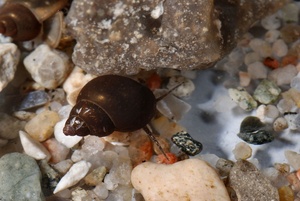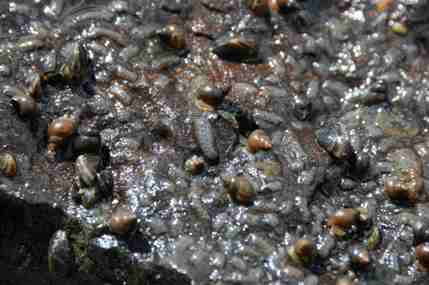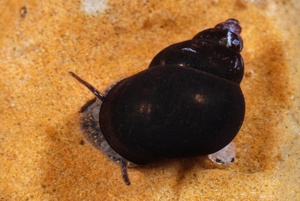
Reproduction
Bithynia tentaculata is a sexually reproducing, dioeccious snail with a life span of up to four years, depending on region (Wächtler 2001). The product of this sexual reproduction is eggs laid in rows (seen in the picture above), with a transparent membrane and yellow embryonic tissue. Eggs are laid from May to July and possibly a second time in October and November when temperatures are 20ºC or higher because temperature is the most important abiotic factor in the reproduction of the faucet snail (Kipp and Benson 2010). The eggs are laid on substrates such as wood, rocks and shells and can be in large clumps of 1-77 eggs (Kipp and Benson 2010). Only 10% of these eggs are expected to live to the first year (Negus 1998). Four to five weeks later a young snail is visible through the membrane and the shell of the developing snail is still transparent enough to see the viscera, heart and gills (Negus 1998). These hatchling snails are only 1.2mm in length and 0.25mg in weight, making both eggs and newborn snails highly predated due to their small size (Negus 1998).
Another important
aspect to the reproduction of B. tentaculata is parasitation, most
often by larval trematodes. These infections are efficient at
castrating the snail due to sporocysts, rediae, or cercariae
developing in the reproductive tissue of the snail and replicating
the parasite (Wächtler 2001). (For more information about parasitism
in B. tentaculata follow this link to
Interactions.) Predation and parasitation create a small life expectancy that requires the
adaptation of many eggs being produced. Females have adapted to the
necessity for more eggs by laying less eggs per spawn but spawning
numerous times.

The reproductive life of Bithynia tentaculata (female)may be summarized as follows (Negus 1998):
1.
Eggs hatch in June. Their life expectancy is less than 8 months. By
the first December only 10 per cent of the young snails have
survived. By then the average mass of individuals has increased from
0.25 to 30 mg.
2.
During the following Spring each female snail lays about 7 eggs. By
the end of the year it has increased in mass by about 55 mg,
reaching a mass of 85 mg by its second December.
![]()
3.
During its second Spring each female snail lays about 23 eggs, more
than three times as many as the previous year. However, during that
year the mass increases by only 35 mg, reaching 120 mg by the third
December.
4.
Some snails may survive to their fourth December, by which time
their life expectancy is only about 6 months. Egg-laying in the
following June may therefore be the four-year-old female snail's
final reproductive act.
The juveniles of B. tentaculata are often observed to have one hatchling demonstrate rapid growth, and a few of medium growth while most remain small (Wächtler 2001). This effect seems to occur from some incidence at an early stage of development, but has not been further studied. As growth continues and the female faucet snail matures more energy must be put into reproduction than growth, so it has been studied weather this would cause a difference in growth based on gender. But despite the reproductive differences, the gender of the snail has little effect on growth (Wächtler 2001). This also means that sexual dimorphism usually is not seen in this population of snails, although the data collected can be indeterminate since at times females or males are the larger sex in the sample (Wächtler 2001).
Return to the Home page

